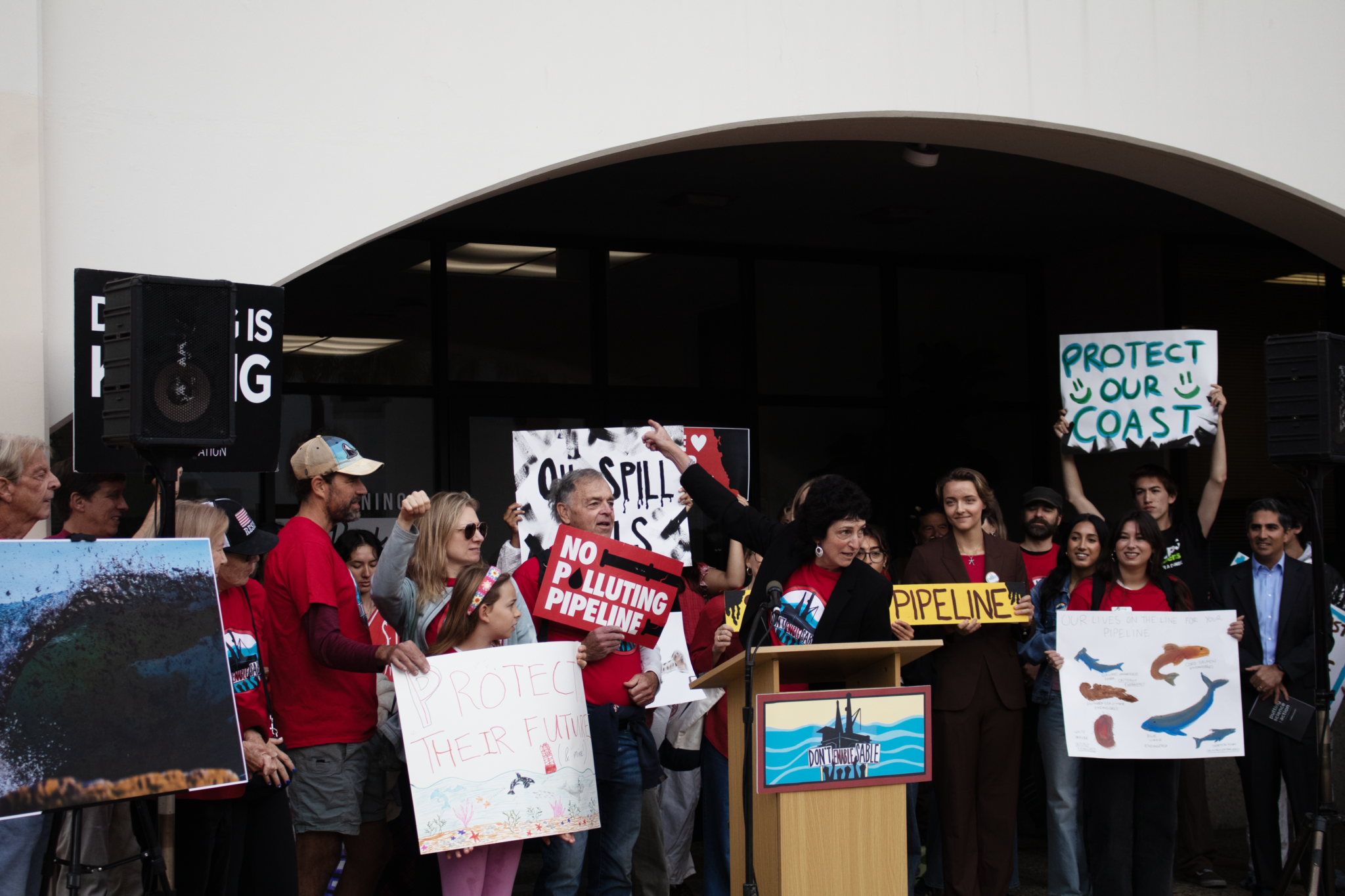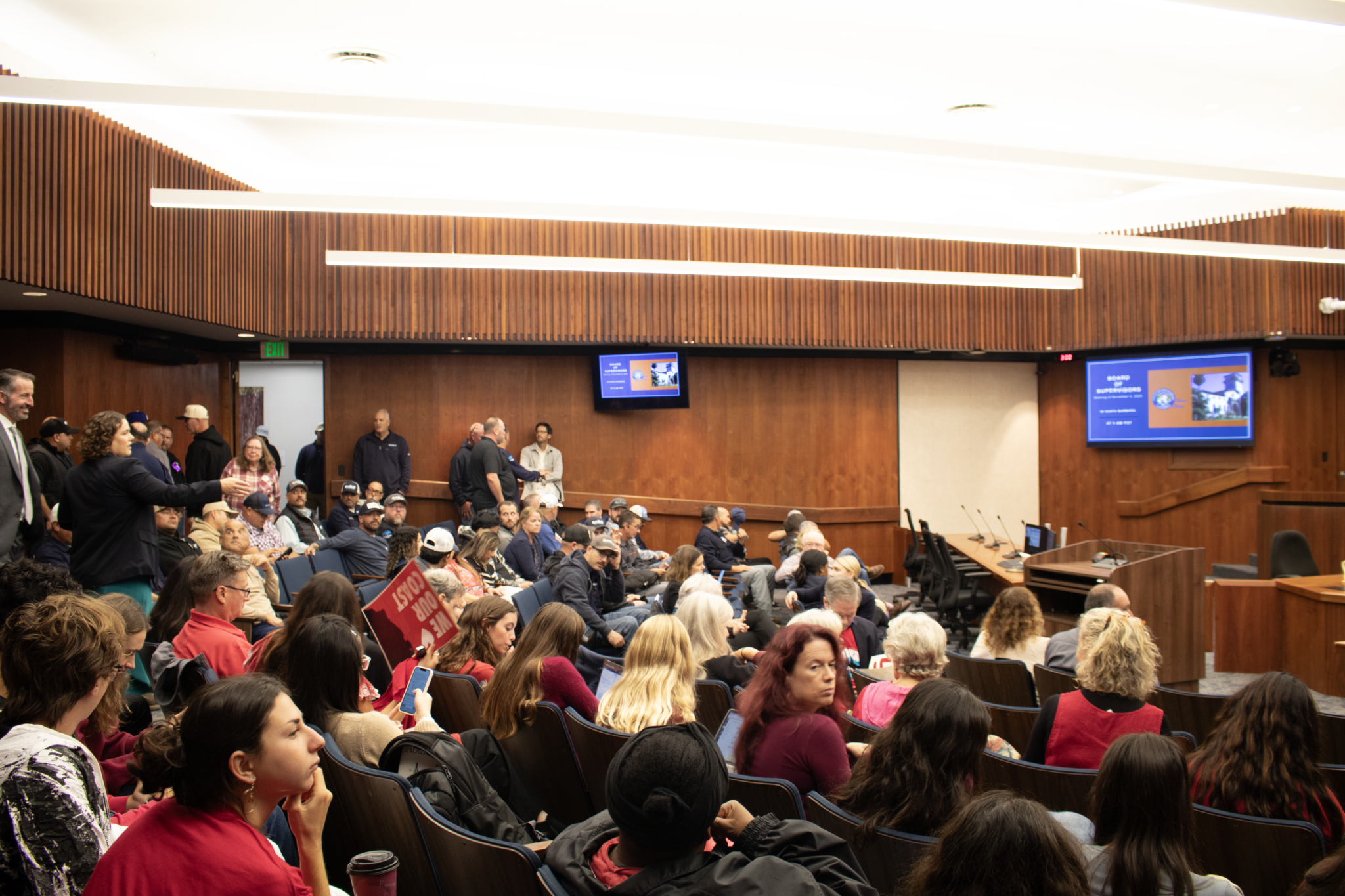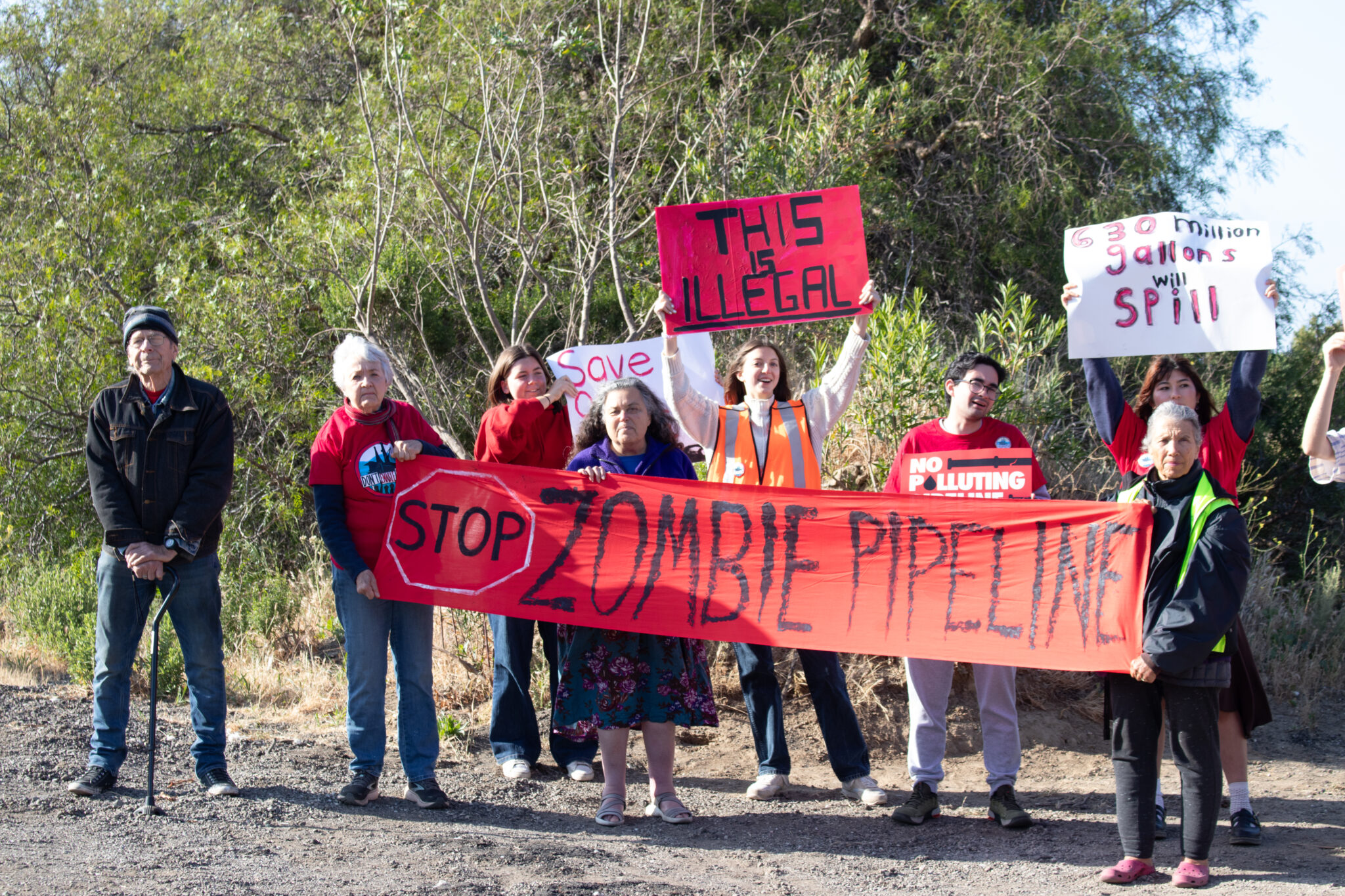
UCSB Stop Sable members protested near Gaviota State Park on May 29. Anusha Singh / Daily Nexus
The Santa Barbara County Planning Commission approved the restart of the Las Flores Pipeline System — the same pipeline that caused the largest oil spill on the Pacific Coast — to upstream oil company Sable Offshore on Oct. 30, 2024.
What ensued was a plethora of legal battles, county hearings and community and student organizing that continue into this very moment and will likely continue into the foreseeable future.
The cause to stop Sable is a pursuit of sustainability — if restarted, the pipeline could double Santa Barbara County’s greenhouse gas emissions and likely result in an oil spill every two years. However, the question remains — is the cause just?

Environmental Defense Center Chief Counsel Linda Krop spoke at the Stop Sable rally, which took place before the Nov. 4 hearing. Anusha Singh / Daily Nexus
The phenomenon of separating sustainability from justice is not new — only in the past few decades have environmental scholars begun recognizing the links between sustainability and environmental inequality. While significant progress has been made in these years, we are now seeing a federal shift in attitude towards environmental justice (EJ) that questions its very legitimacy as a guiding principle of environmental policy.
In March, Environmental Protection Agency (EPA) administrator Lee Zeldin eliminated all environmental justice offices and positions within the organization, placing nearly 200 people across 10 EPA regional offices on administrative leave.
“Our goal at the EPA is going to be to remediate these environmental issues directly,” Zeldin claimed to the press. “We’re not going to discriminate.”
This rollback is not just the product of a Trump-era rejection of so-called “woke politics.” It is a wake-up call — a reflection of how deeply environmental justice remains misunderstood across the political spectrum.
Environmental justice, as defined by the EPA itself before these eliminations, is the “fair treatment and meaningful involvement of all people — regardless of race, color, national origin, or income — in the development, implementation, and enforcement of environmental laws and policies.”
The EJ movement first gained traction in the early 1980s when residents of Warren County, North Carolina, a predominantly Black community, protested the state’s decision to dump toxic polychlorinated biphenyl (PCB) waste in their county. Their resistance marked one of the first moments in U.S. history when environmental policy was recognized as a civil rights issue.
What became clear from the ordeal in Warren County and from the decades of organizing that followed was that the traditional notion of “the environment” as wilderness — something distant, green and untouched — was no longer enough. An EJ scholar, Robert Bullard, often regarded as the father of environmental justice, wrote:
“The environment is everything: where we live, work, play, go to school, as well as the physical and natural world. And so we can’t separate the physical environment from the cultural environment. We have to talk about making sure that justice is integrated throughout all of the stuff that we do.”
In a place like Santa Barbara, especially on a college campus, we pride ourselves on being stewards of the environment. We march for climate action and brand ourselves as champions of sustainability. But as Bullard reminds us, the environment is not just the coastline we rally to save; it is also the refineries, the pipelines, the job sites and the communities that exist alongside them. It is the community members who live downwind, who clock in at dawn and whose livelihoods depend on the very industries we often vilify from a comfortable distance.
At the countless Sable hearings that have taken place this past year, that disconnect is impossible to ignore. The workers who fill one side of the room — many of them wearing company jackets, sitting quietly in rows — stand in stark contrast to the faces of students and residents who speak out against the project.

Anusha Singh / Daily Nexus

Anusha Singh / Daily Nexus
“I’d like to remind everyone that we live here too. We care about our coast,” José Crespo, a Sable employee, said at the Nov. 4 Santa Barbara County Board of Supervisors meeting. “We can protect the environment and support working families at the same time.”
While Crespo rallied in full support of continuing Sable’s work on the Santa Barbara coast, his sentiment and the sentiment of several other Sable employees should not be ignored. His words complicated a narrative that had felt clear-cut: Shutting down Sable equals saving the coast. Yet his plea revealed another truth — that environmental protection cannot be separated from economic survival.
At that same meeting, another Sable worker, Pascual Morales, echoed Crespo’s sentiment.
“For me, this isn’t just a job. This is part of my life … Please don’t separate us from the community. We live here too. We’re your neighbors, we’re your family,” he said.

Several Sable workers filled the conference room during the Nov. 4 meeting. Anusha Singh / Daily Nexus

Anusha Singh / Daily Nexus
In a county that celebrates environmentalism, this tension exposes an uncomfortable truth: We have built an image of sustainability that too often leaves justice out of the picture. We have learned to defend nature but not always the people whose labor sustains it.
This disconnect hasn’t gone unnoticed by the Board of Supervisors.
“I’m not here to put people out of jobs. I want [Sable employees] to transition from a different industry to a new one, where [they] can continue to provide for their families,” Santa Barbara County Supervisor Roy Lee said at the Oct. 21 Board of Supervisors meeting.
Lee’s comment points toward what true sustainability should look like — a just sustainability. If we shut down Sable without addressing the economic inequities that could follow, we risk reinforcing the same cycles of injustice that environmentalism is supposed to challenge.
During the Nov. 4 meeting, the Board of Supervisors voted 4-1 in favor of denying the transfer of a series of permits to Sable, preventing further work on the Las Flores Pipeline System. Although this decision is not definitive nor permanent, it is a step in the right direction.
However, without a just transition that provides new jobs, retraining and community investment, it’s an incomplete one. Environmental justice demands that we hold two truths at once: Fossil fuel infrastructure must end, and the people whose livelihoods depend on it deserve to move forward with dignity.
Because preventing one environmental injustice without creating a just solution isn’t progress — it’s repetition.





















In re: Haskell’s Beach After this “rain washes you clean moment,” venture forth to Haskell’s, past the famous WWII Ellwood Beach and see for yourself the protruding shards still remaining after the current beach erosion. The highest tides of the year are coming next month due to the earth’s perihelion path around the sun the first week of next January. There was still major debris there in 1994, when I hired a private investigator to document for me the damage. I suppose with the establishment of the Baca Resort, there was some mitigation work performed. Rest assured, the insanity still… Read more »
misspelling-Bacara Resort & Spa
Bacara Resort & Spa–the Eagles’ version of “Hotel California”
Ashes at Bacara The Pacific is a blade, its edge honed on centuries of salt, and Bacara gleams— a cathedral of glass, a mausoleum dressed in silk. Mirrors multiply me, fractured dolls in corridors where orchids bleed their perfume, white throats slip open to spill eternity. The champagne is ash in disguise, its fizzle a false resurrection. Knives sleep beneath the linen, their silver tongues whispering of a feast that never ends. “Welcome,” the voices croon, lacquered lips, eyes like polished stones. The song coils in the chandeliers, Hotel California’s refrain— a lullaby sharpened to a snare. You may check… Read more »
To all UCSB students there with chutzpah:
Venture forth to Haskell’s after the next storm this coming Thanksgiving and tell me what you have found out. Post it here online for all the world to see before this next snippet drops off.
We might have to file for an injunction in Federal District Court sometime in the near future.
Stay tuned here.
Most probably in the Central District located in Los Angeles in the Federal Building.
There used to be an easement from the main highway there leading to the Bacara–it was at this point one could access the beach near the remaining pier still standing. The remaining remnants on the shoreline can still be found just due east and the submerged
pier pilings are found some 400 yards due east of the easement–they have only been cut at the sand level some fifty years ago and have since had fifty-some years to once again raise their hideous monstrous heads still submerged in the Pacific.